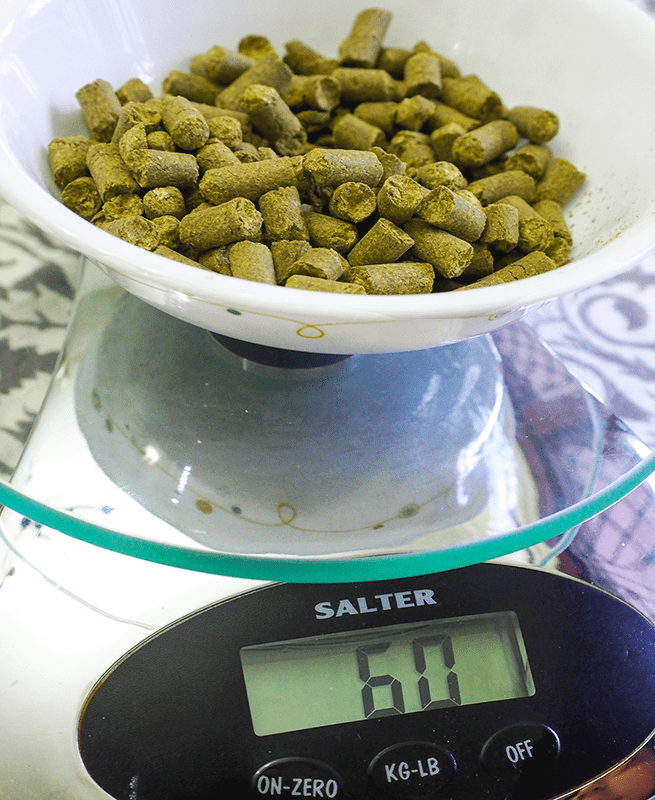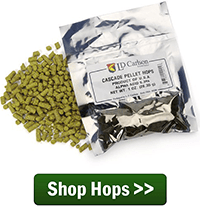 While noble hops are revered for their delicate aromatic qualities and are lower in alpha acid content, high alpha hops (or “super alphas”) offer maximum bittering potential per ounce. Super high alpha hops will have 10% AA or higher, some into the high teens!
While noble hops are revered for their delicate aromatic qualities and are lower in alpha acid content, high alpha hops (or “super alphas”) offer maximum bittering potential per ounce. Super high alpha hops will have 10% AA or higher, some into the high teens!
What this means for the budget-minded brewer (and who isn’t?), is that you can get the same amount of bitterness using less hops with a high alpha hop than with a lower alpha acid hop. This not only saves money, but also reduces the amount of trub in the kettle and the volume of beer lost in the trub. Here’s an example of how to do a hop substitution:
Hop A has an alpha acid content of 5%. The beer recipe calls for one ounce. Hop B has an alpha acid of 10%. You can use half an ounce of Hop B to end up with the same amount of bitterness and IBUs.
This being said, not all alpha acids are created equal. Cohumulone is a type of alpha acid that tends to present a harsher bitterness, so it’s important to key an eye on the percentage of cohumulone when switching out one type of hop for another. Otherwise, you may change the quality of the bitterness in your beer from something clean or soft into a bitterness that’s harsh or biting. A hop acid chart can be helpful in identifying typical cohumulone content, but the best thing to do is experiment and gauge for yourself what hops provide the qualities you enjoy.
A rule of thumb: these super high alpha hops seem to do best in bigger beers – beers with lots of flavor. For more delicate beers, use the lower alpha acid hops.
Without further ado, here are some of the most popular super high alpha hops used by homebrewers:
- Bravo –
 Bravo is sometimes called a “super Cascade.” It’s a good bittering hop with desirable flavor and aroma characteristics described as fruity and floral. (14-17% AA)
Bravo is sometimes called a “super Cascade.” It’s a good bittering hop with desirable flavor and aroma characteristics described as fruity and floral. (14-17% AA)
- Chinook – Chinook is a classic American bittering hop. When used in later hop additions, it gives an herbal, somewhat smoky character. (12-14% AA)
- Citra – Citra is one of the more popular varieties of high alpha hops. In addition to the high alpha acid content, Citra offers flavors and aromas of grapefruit, melon, and tropical fruit. (11-13% AA)
- Columbus – Columbus is one of the high alpha hops with flavor and aroma characteristics described as oniony, citrusy, and resiny. Sometimes called Tomahawk. (14-16% AA)
- Galena – A clean bittering hop that’s well suited for a variety of styles. (10-14% AA)

- Horizon – Good for hop-forward beers like pale ales and IPAs. When used for flavor and aroma additions, it lends herbal, earthy, and spicy characteristics. (11-13% AA)
- Millenium – Released in 2000, Millenium is a cross of Nugget and Coumbus with floral, resiny, and spicy characteristics. (14.5-16.5% AA)
- Newport (13.5-17% AA)
- Simcoe® – Simcoe is another of the high alpha hops from the Cascade hop family. Its strong piney characteristics make is popular in IPAs and double IPAs. (12-14% AA)
- Sorachi Ace – Sorachi Ace is a cross between Brewers Gold and Saaz. It has a distinct lemony quality. (10.5-12.2% AA)
- Summit – Summit is one of the highest of all the alpha hops with citrus characteristics. (17.5-19% AA)

- Warrior – Warrior is a newer bittering hop with very high alpha acid content. Flavor and aroma desribed as grapefruit, lemon, and pine. (14-16% AA)
- Yakima Magnum – Yakima Magnum is a clean and versatile bittering hop derived from the German-grown Magnum hop. (12-14% AA)
- Zythos – Zythos is a blend of popular American hops, featuring notes of pineapple, tropical fruit, and a touch of pine. (10-12% AA)
What are some of your favorite super high alpha hops and why? Share in the comments below!
—–
David Ackley is a beer writer, brewer, and self-described “craft beer crusader.” He holds a General Certificate in Brewing from the Institute of Brewing and Distilling and is founder and editor of the Local Beer Blog.

Jeff — You’re right, substituting hops in this way should be done for the bittering additions rather than the later additions in order to avoid changing the flavor/aroma profile of the beer. Since some of the super alpha hops have different bittering character than their low alpha counterparts, I’d recommend using them primarily for the "Imperial" and "Double" strength beers.
I just read your article on substituting high alpha hops in less quantity to save money when brewing beer. I agree that you can get same bitterness with less, but I wonder, how are you changing the flavor by using less of one hop in place of another, wouldn’t that effect the over all flavor, thus creating a different beer then the one you are setting out to brew?